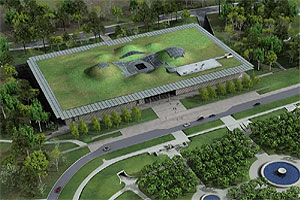 At no other time, in the short history of our species, have humans faced greater hurdles to our continued existence. We are threatened on all sides by disasters of our own making including global warming, the imminent collapse of the ocean’s fisheries, and the destruction of the world’s rainforests. That’s why it’s the perfect time for the new California Academy of Sciences to be built in San Francisco’s Golden Gate Park.
At no other time, in the short history of our species, have humans faced greater hurdles to our continued existence. We are threatened on all sides by disasters of our own making including global warming, the imminent collapse of the ocean’s fisheries, and the destruction of the world’s rainforests. That’s why it’s the perfect time for the new California Academy of Sciences to be built in San Francisco’s Golden Gate Park.
This beautiful building may be one of a handful in the world with a platinum-level LEED certification. LEED (Leadership in Energy and Environmental Design) is a standard rating system created by the US Green Building Council. As the definitive green certification, a LEED score tells the world how sustainable a building is. The LEED standard measures performance in 5 key construction categories: Site, Water Efficiency, Materials and Resources, Indoor Environmental Quality and Innovation and Design Process.Platinum-level certification is its highest honor.
Curiously, the green building movement is leading the modern world in the direction of its more "primitive" roots. After all, a couple of hundred years ago all homes were made of materials that rapidly biodegraded into the environment. Sustainable sources of energy, such as water and wind, were used to power grinding mills. But modern times demand more. They demand that a building have a minimal environmental footprint, last hundreds of years AND withstand earthquakes.
The new Academy takes on this challenge. It will be insulated with recycled denim jeans instead of fiberglass. The new building will have a living roof with a million native California plants growing on it. The plants won't need irrigation but will attract and foster local fauna such as hummingbirds and butterflies. The living roof will provide superior insulation, and capture gray water for use throughout the facility. In the event of an earthquake, huge aquarium tanks throughout the building will act as shock absorbers. Moreover, 100% of the building's steel is recycled and at least 50% of the wood will be sustainably harvested. In short, this is the perfect building to push forward a vision for a more sustainable world.
Donovan Rittenbach is the Web Manager for the California Academy of Sciences. He has a Master's Degree in Multimedia, and 12 years of web & multimedia industry experience.
